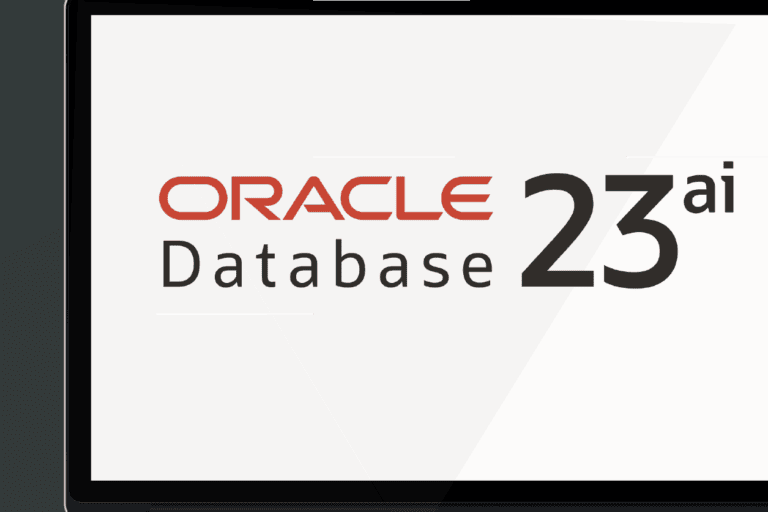Today Oracle announced the latest version of its database. It will go by the name Oracle Database 23ai. As the new name suggests, AI plays a starring role in this latest update. Oracle wants to better link AI and data in several areas. It must become easier for application developers and applications themselves to use data from Oracle databases in combination with AI.
With Database 23ai, Oracle is taking a different direction when it comes to naming its own database. Just last September, the company released Database 23c, but it is already coming out with Database 23ai. This replaces the old name. Oracle says goodbye to the ‘c’ suffix it has used since version 12 in 2013.
The name change may not seem that interesting, but it actually is if you look at it from a broader perspective. After all, the ‘c’ stood for cloud. The fact that this now becomes “ai” is a signal that we have moved from the era of cloud to the era of AI. That is our interpretation of it anyway. This is something you often hear from people in the industry these days. In this regard, Oracle is putting its money where its mouth is by changing the name of the product that made it big and that can still be seen as being at the core of the company.
More than a name change
Coming up with a new name is not that difficult, of course. What ultimately matters is whether Oracle also brings something new. You can read about that in this article. In addition, we also address some other important updates in Oracle Database 23ai. Because while AI may be an important component, there are certainly other areas where innovation is needed. Especially if Oracle wants to be able to keep the promise that you can handle all workloads and data models and types on a single database engine with a single “converged” database.
The most important new features (out of a total of more than 300) in Oracle Database 23ai fall into three categories. The first one is how data and AI interact and can integrate more. A second theme is what Oracle Database 23ai can offer developers who develop applications and need to be able to access multiple data types. Third, new features are available for dealing with mission-critical data.
AI and data
In the area of AI and data, the mission for Oracle is clear. It wants to make AI as accessible as possible. That is, AI must be able to easily and scalably access data in databases. That means the underlying architecture must be simple and scalable. In other words, Oracle’s relational database must somehow be able to handle multiple data types and models, among other things.
Without a doubt, the most important new feature in Oracle Database 23ai in terms of AI is Oracle AI Vector Search. With this, Oracle links structured data contained in relational databases with unstructured data. This data exists in the form of vectors, which describe the content. These vectors store the semantic meaning of unstructured data (such as images) in the relational database. This makes it possible to search and query both types of data simultaneously. By also adding a special kind of indexing, Oracle additionally ensures that this also happens quickly. Crucial to mention here is that no data needs to be moved around, so there is no need to keep an eye on consistency between databases.
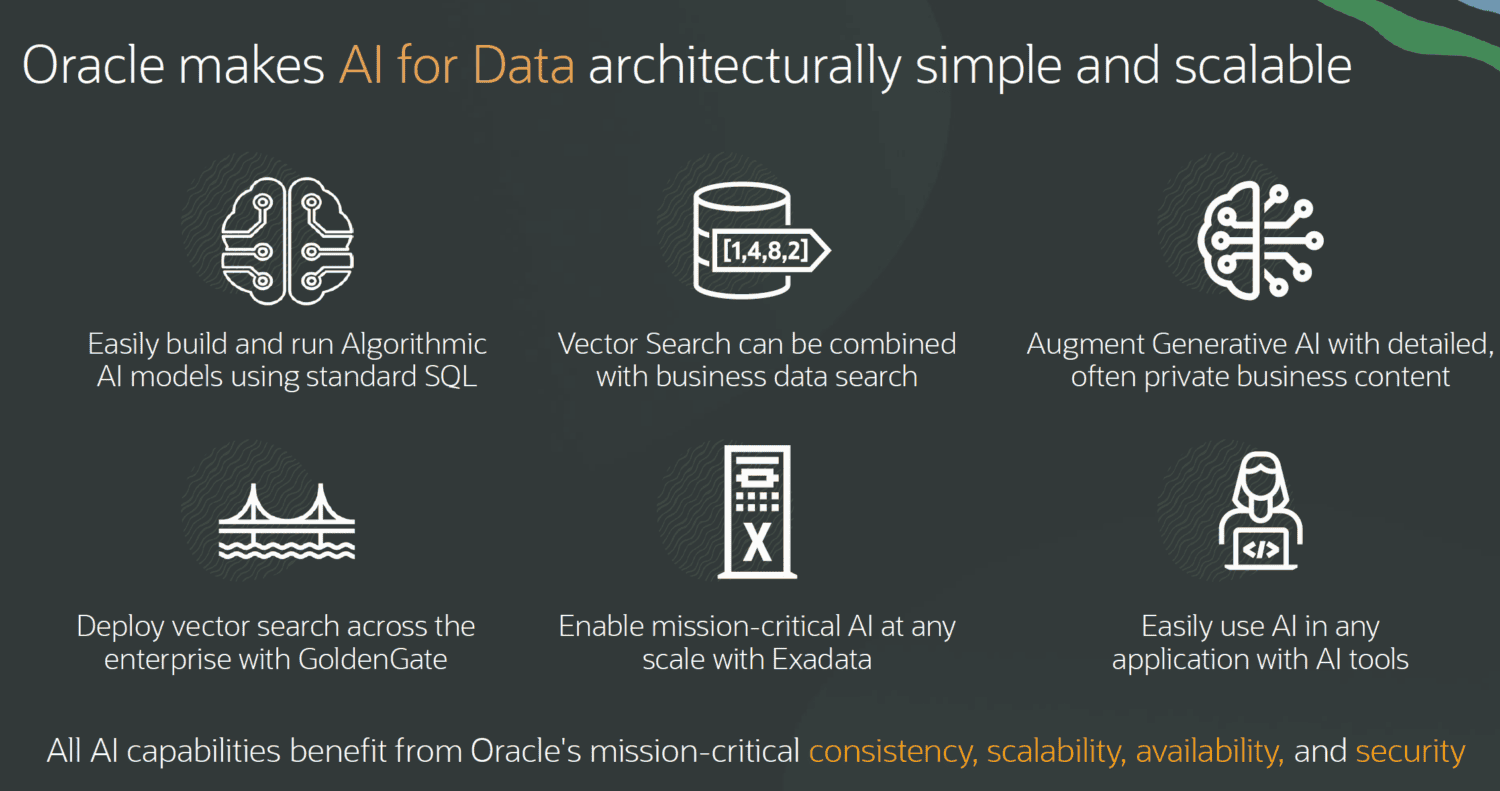
Two other features of Database 23ai that come to mind when it comes to AI and data are Oracle Exadata System Software 24ai and OCI GoldenGate 23ai. The former is closely related to AI Vector Search. In fact, it should ensure that this is scalable. Oracle promises several orders of magnitude of acceleration. This makes it possible for applications to deploy AI Vector Search in conjunction with large data volumes and large numbers of users.
Oracle developed OCI GoldenGate 23ai to better support vectors. With this latest version, this data replication tool in OCI can replicate vectors in real-time across multiple vector stores. The idea behind this is that it enables organizations to quickly get started with AI. This is because it allows you to quickly and securely replicate the data you need into Oracle Database 23ai, where it is then prepared for Vector AI Search. So this does mean moving (in this case replicating) something. So completely without moving data, the deployment of Vector AI Search will not be for all organizations.
Accelerating application development
As mentioned, there is more news in Oracle Database 23ai besides the AI component. There is quite a bit of emphasis on better supporting application developers. Oracle also wants and needs to make that architecture as simple and scalable as possible. After all, the data component is a crucial part of almost every application. Developers need to be able to add it as quickly as possible in the development process.
One of the problems developers run into is that there are quite a few different types of data. In Oracle Database 23ai, the main focus is on a new feature for linking JSON and relational databases. With JSON Relational Duality, Oracle has a solution to the mismatch between how some applications want to use data and how a relational database stores data. In a nutshell, JSON Relational Duality makes it possible to combine the benefits of JSON and relational data models, on the same data. It is a duality view on top of relational tables. The idea is that developers then no longer have to make compromises when developing applications. Oracle therefore calls the new feature JSON Relational Unification.
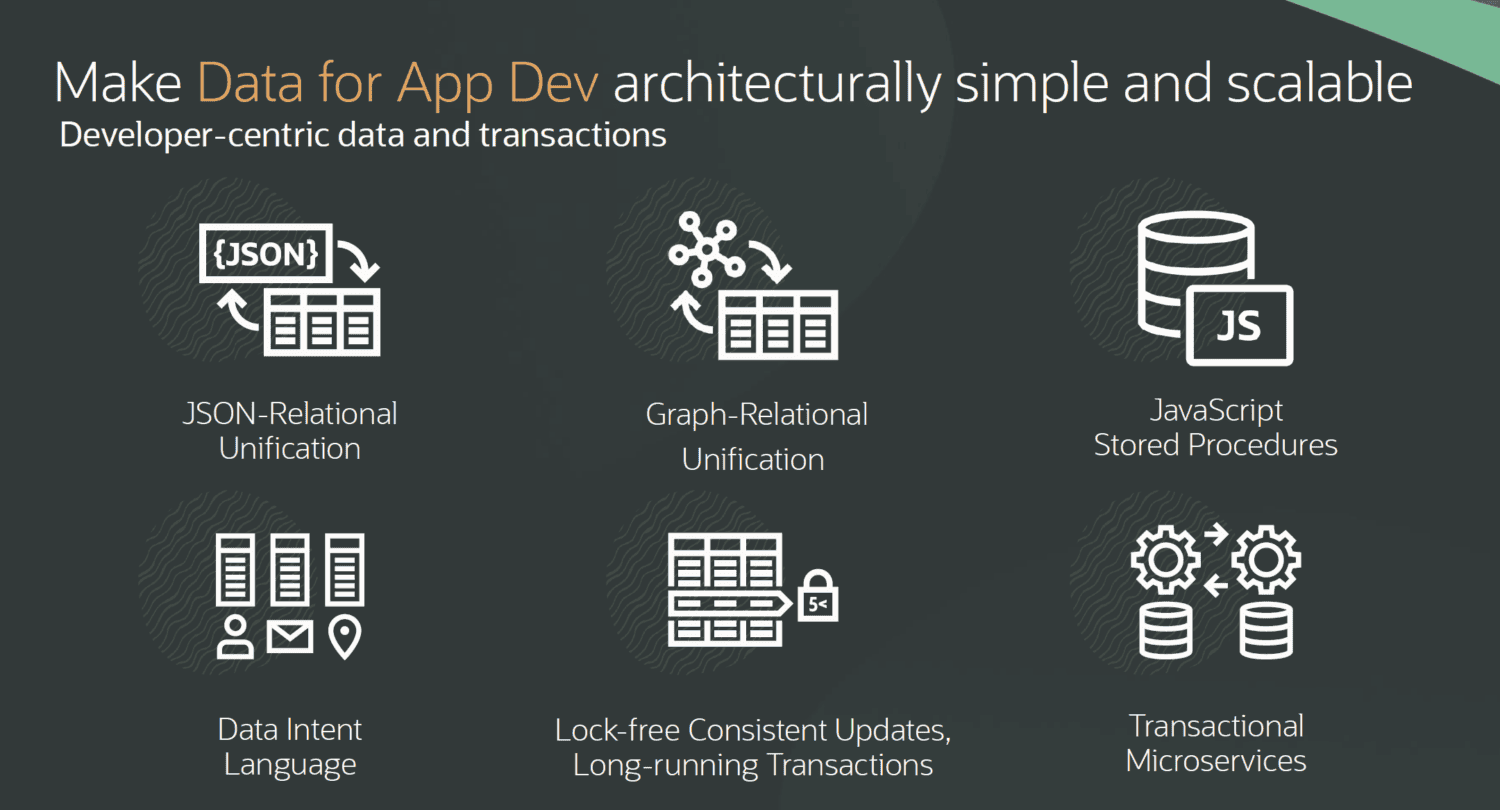
Furthermore, Oracle has added Graph Relational Unification in Database 23ai. With something it calls Operational Property Graph, it is possible for developers to build applications that can handle different types of data. This is possible thanks to property graph queries. This allows applications to query all types of data that Oracle Database supports, such as relational data and JSON data.
Mission-critical data
The final overarching theme in the release of Oracle Database 23ai revolves around mission-critical data. Here, the addition of Raft to the Oracle Globally Distributed Database immediately springs to mind. The Globally Distributed Database allows data to be stored scattered across multiple locations, while applications see and address a single database image. To that, Oracle is now adding Raft replication. This makes it possible to add automatic failover to it this distributed environment. This virtually in real time (“single digit seconds,” as Oracle calls it), without data loss. This should make it possible to build stronger systems, with higher availability.
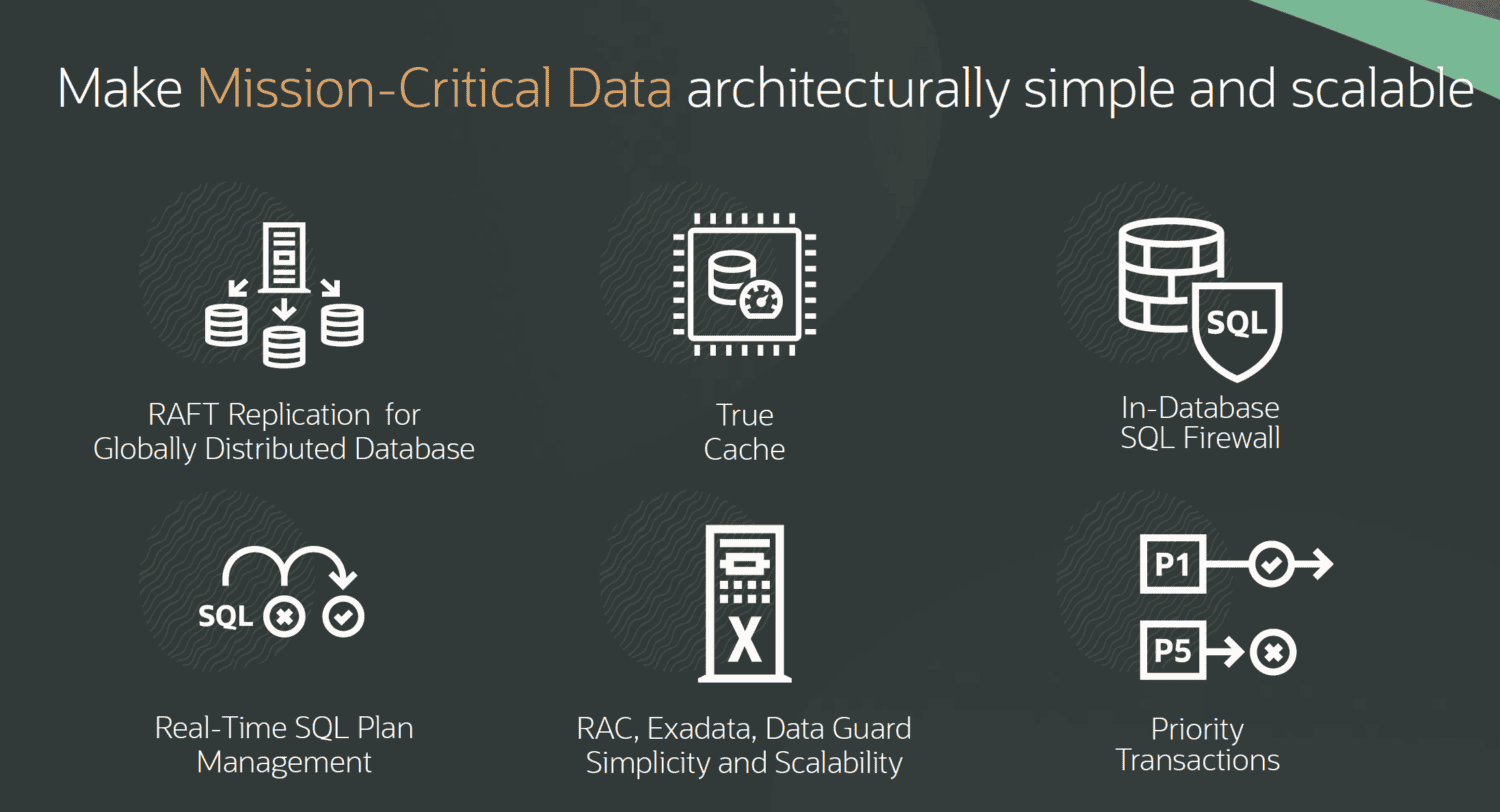
A second component in this segment is Oracle True Cache. This is an in-memory middle-tier cache. It should be an alternative to other mid-tier caches such as Redis. According to Oracle, Oracle True Cache is friendlier to the developer. The developer does not have to write additional code to ensure that the cache is populated and remains consistent. Oracle True Cache handles all that itself.
One last feature we want to highlight here is the new In-Database SQL Firewall that Oracle is introducing in Database 23ai. This is mentioned a little bit as an afterthought here, but is also very important. SQL injection is a popular way for attackers to get in somewhere and disrupt things. That should no longer be possible with this In-Database SQL Firewall, if at all. After all, the firewall runs inside the database itself, not outside it. Any attacks are already blocked and neutralized in the database engine.
Availability
Oracle Database 23ai is available on Oracle Cloud Infrastructure (OCI), Oracle Exadata Database Service, Oracle Exadata Cloud@Customer and Oracle Base Database Service. In addition, it is also available on Oracle Database@Azure. The version for use on-premises is coming later this year (2024). Also good to mention is that Oracle Database 23ai is obviously an LTS (Long-Term Support) variant, because Database 23c was as well. Oracle promises to provide up to eight years of support for this. The upgrade is free for customers with a support contract.
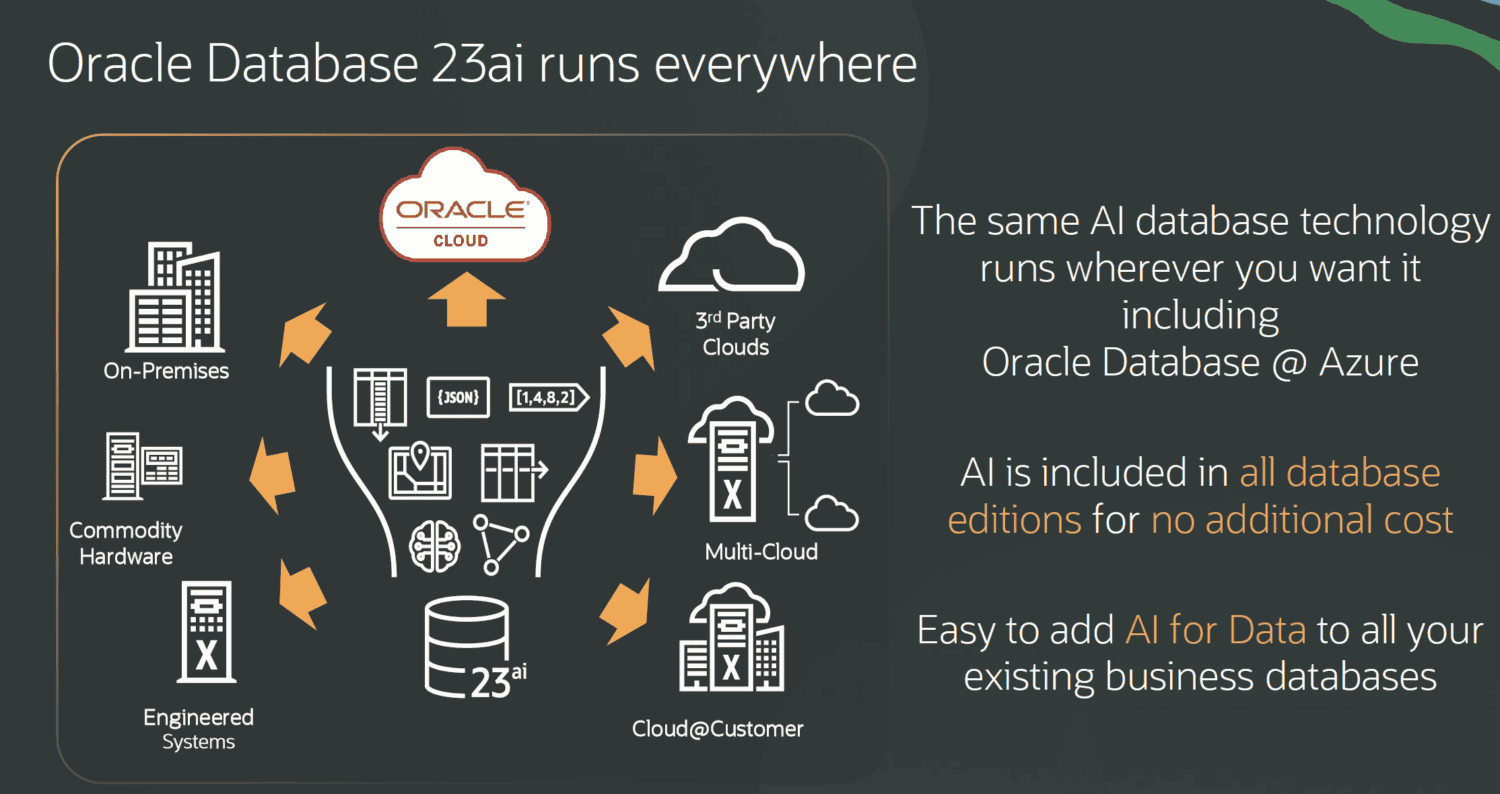
Also read: Oracle integrates MongoDB JSON workloads with Autonomous Database
